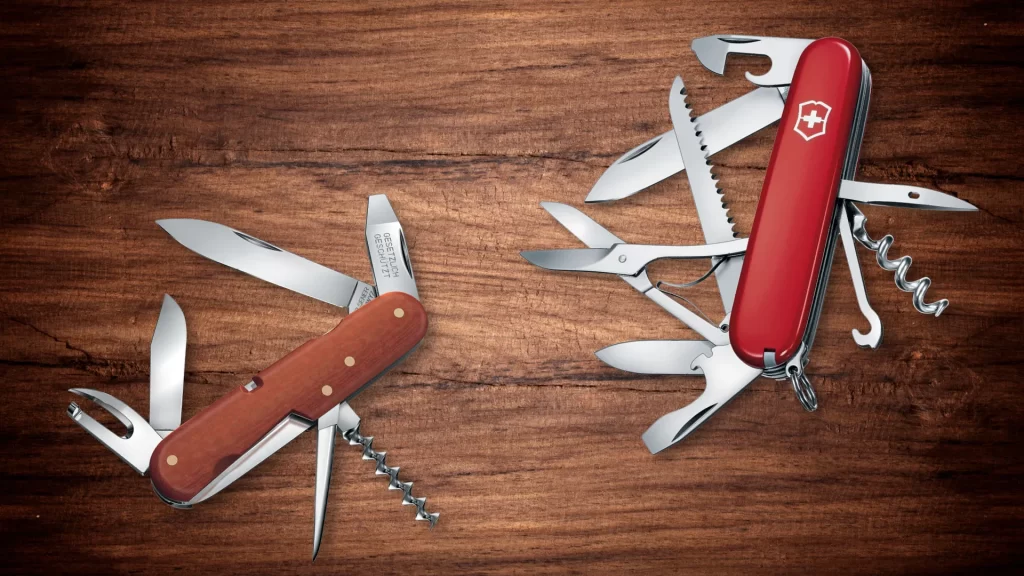It is a simple tool with multiple uses, an all-in-one tool that has had a long history that has often gone unrecognised, and a versatile structure that has been in our bags, and pockets for far too long, in this article let’s trace the history of the Swiss Army Knife.

The first knife was made in 1884 for Swiss soldiers to ensure that soldiers on a hunt could easily repair their guns using some basic tools and skillsets, the knife came in handy in cutting canned foods, opening material, and even as a small safety option if need be. The Swiss knife concept dates back to the 1880s when the Swiss military recognised the necessity for a compact and multipurpose instrument for soldiers. Initially, due to a lack of sufficient manufacturing facilities in Switzerland, production was outsourced to Germany. However, Swiss inventor Karl Elsener later emerged and developed a solution that satisfied their needs, resulting in the renowned Swiss knife.
The copyright of the original Swiss knife lies with Victorinox and Wenger S.A. when their founder Karl Elsener made the first knife. Little did he know that this small, ordinary-looking creation would become essential to everyone’s daily life and adventure. This device was critical for anybody in cases of emergencies while traveling, in one’s toolkit, and more.

The company Victorinox was named after Karl’s mother who had recently passed away and in 1921, the company started using stainless steel in the making of the knives the term inox was added to Victoria’s name which means “stainless steel” in French.
The making of the Swiss knife began in a small village called Ibach in the Canton of Schwyz, Switzerland. Karl Elsener and his mother Victoria founded a cutlery factory in 1884 to provide surgical equipment for local hospitals and surgeons. After developing amazing manufacturing power and bringing in expert cutlets from all over the world, the factory was awarded a contract to create a new knife for the Swiss Army. The knives only went global and were exposed to the American population during World War 2 when American soldiers struggled to say their original Swiss name and their literal translation “Swiss Army Knife” was used instead.
The company procures around 2,400 metric tonnes of stainless steel, which then are cut into two 2-millimetre thick blades, plastic grinding rounding tools are used to round off the edges of the blade and smoothen it out. Afterward, the blades receive a “certificate of authenticity” before they are placed in the oven to harden the steel and set them in place. The plastic castings which hold the blades are embossed with the logo of the company. The officer’s knife is assembled in a machine while the others are meticulously hand crafted.
The basic Swiss Officers’ Knife is a multitool object with 16 blades and attachments that can perform 29 functions. The Swiss Army Knife boasts a diverse range of 200 models. Traditionally, older versions featured essential tools like a blade, can opener, toothpick, tweezers, corkscrew, Phillips-head screwdriver, and magnifying glass. Modern iterations may also incorporate advanced functionalities such as a USB flash drive, digital clock, altitude measurement device, LED light, and even a laser pointer. Notably, Victorinox knives are included in NASA astronauts’ standard toolkits, highlighting their reliability and versatility in demanding environments.
Victorinox pocket knives have remained popular displays in museums around the world. The Swiss Officer’s Knife, which has been housed in the Museum of Modern Art in New York since 1977, and the Tinker pocket knife, which was exhibited in the “Designer Maker User” exhibition at the London Design Museum in 2016, demonstrate the brand’s continuing appeal and design brilliance. These knives are recognised as iconic emblems of Swiss design, valued for their global significance and inventiveness.
The Swiss knife is a timeless icon of invention, utility, and Swiss workmanship. Its famous history dates back to the 1880s, when it was used as a rudimentary military weapon before becoming an internationally recognised icon of practicality and design. With a history of versatility and dependability, the Swiss knife continues to enchant fans and experts alike, capturing the soul of Swiss precision and inventiveness in every fold and function.
References
https://www.popularmechanics.com/adventure/outdoor-gear/g60216152/best-swiss-army-knives/
https://designwanted.com/swiss-army-knife-design-icon/
https://www.atlasobscura.com/articles/the-simple-elegant-history-of-the-swiss-army-knife
https://www.wired.com/2010/09/tracing-the-army-knifes-swiss-history/





